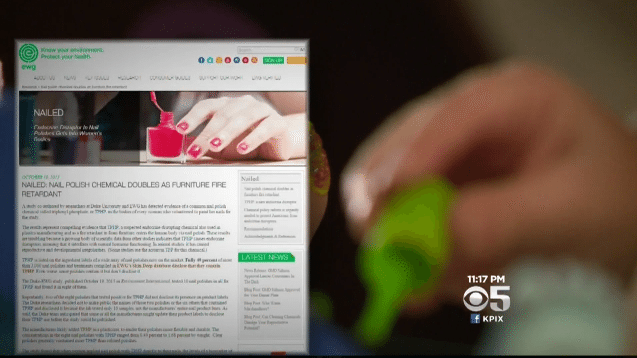Don’t you hate it when you realize your dad was right?
Here’s a quote from mine last night when I sent him a press release titled “Study Finds Toxic Nail Polish Chemical In Women’s Bodies”.
I have been telling every woman I have known for the last 30 years, but they didn’t listen.
– Randy Watts
It’s true, he has. (And he forwarded that email to every one of em’).
In fact, just last week he brought it up as my nieces were painting his nails—noting that the cheap little girl nail polish was burning his skin.

For years, we’ve disregarded Dad’s concerns. I mean, nail polish chemicals can’t penetrate your nails, right?
Well, according to this joint study by researchers at Duke University and the Environmental Working Group, wrong. They found the common nail polish chemical triphenyl phosphate, or TPHP, in the bodies of every woman who volunteered to paint her nails for the study.
TPHP is the same chemical used in flame retardants and plastics manufacturing. When tested on animals, EWG says it has caused reproductive and developmental issues.
One of the greatest concerns, as you might imagine, is for little girls “exposed to a suspected hormone-disrupting chemical” as their bodies are developing and entering puberty.
As a mom myself, you’d better bet I’m listening now (sorry dad).
Researchers at Duke University and Environmental Working Group have found evidence of a suspected endocrine-disrupting chemical widely used in popular nail polishes in the bodies of more than two dozen women who participated in a biomonitoring study. The study, published in Environmental International, found that all women had a metabolite of triphenyl phosphate, or TPHP, in their bodies just 10 to 14 hours after painting their nails.
Source: Duke-EWG Study Finds Toxic Nail Polish Chemical In Women’s Bodies | EWG
And if hormone disruptions aren’t enough, EWG points to new research that may link TPHP to weight gain and obesity.
Now, the Personal Care Council, the industry group representing the nail polish manufacturers, released a statement saying the new research is “speculative, misleading and does not use sound science to assess the safety of an ingredient which has a long and well documented history of safe use.”
The council’s statement says “(TPHP) has been widely and safely used across many industries,” including to prevent “electrical, automobile and furniture fires.”
The ingredient is used to make the polish more flexible and durable, and EWG found that clear nail polishes tend to contain even more than colored polishes.
Nearly 50 percent of the 3000 nail polishes in the EWG’s Skin Deep Cosmetic Database admittedly contain TPHP. However, EWG contends that other polishes they tested contain the chemical, it’s just not listed as an ingredient.
According to EWG’s Skin Deep® cosmetics database, more than 1,500 nail products including polishes made by Sally Hansen, OPI and Wet N Wild, contain TPHP.
Click here for a list of brands that list TPHP as an ingredient.
The Personal Care Council says it doesn’t believe that nail polish is an important contributor to long-term TPHP exposure, though EWG points out that the average woman paints her nails once a week.
Researchers believe the chemical is absorbed though the capillaries in the cuticle and that other solvents in the polish may actually make the nails themselves more permeable.
EWG launched a consumer petition to pressure popular nail polish brands to stop using TPHP.
Though, in the mean time, the EWG has compiled a list of products sans-TPHP on their Skin Deep App & Database.
UPDATE:
This #NewsMom blog ultimately became a TV news story on CBS San Francisco.
Normally I blog about the stories I cover on CBS San Francisco. But in the case of this report on nail polish chemicals, it was the other way around. The TV story idea actually came from this […]
Source: Nail Polish: Out of Bottle, Into Your Body • NewsMom
NEWSMOM NOTE:
As a reporter, I like to background my non-profits. Here’s a link to EWG’s rating on Charity Navigator, if you’re interested.



. ” Fingernails are substantially more permeable than the adjacent tissue , or for that matter any real any skin, the most permeable part of the human body” so says Reinhard Henselka-REA- California State Registered Environmental Assessor,